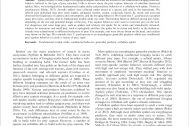Content
Spiders employ a wide range of foraging strategies and some are known to use conditional foraging behavior, which is tailored to the type of prey attacked. Little is known about the prey capture behavior of cribellate titanoecid spiders. Here, we investigated the fundamental trophic niche and predatory behavior of a cribellate-web spider, Titanoeca quadriguttata (Hahn, 1833). Juvenile spiders were collected under stones in a quarry and used in the experiment. We offered each individual nine prey types (spider, springtail, termite, cricket, cockroach, beetle, fly, moth, and ant) and observed the frequencies of capture and consumption, and the foraging behavior. We found that Titanoeca quadriguttata accepted many prey types, and thus, that its fundamental trophic niche was wide. The hunting behavior differed among prey types, depending on the size and potential danger of the prey. Two capture behaviors were used to overcome prey on the web. For dangerous and some large prey, such as spiders and crickets, the spider bit its victim and immediately retreated, whereas for innocuous and small prey, such as springtails and flies, the spider bit its victim and held it in the chelicerae. Attacks were administered to different body parts of prey. For example, ants were always bitten on the head, and crickets were bitten on the legs. We conclude that Titanoeca quadriguttata is an euryphagous generalist predator which uses conditional prey capture behavior to catch a variety of prey types.



